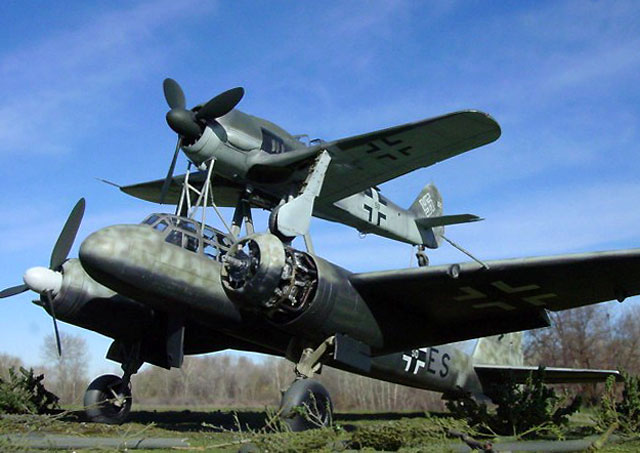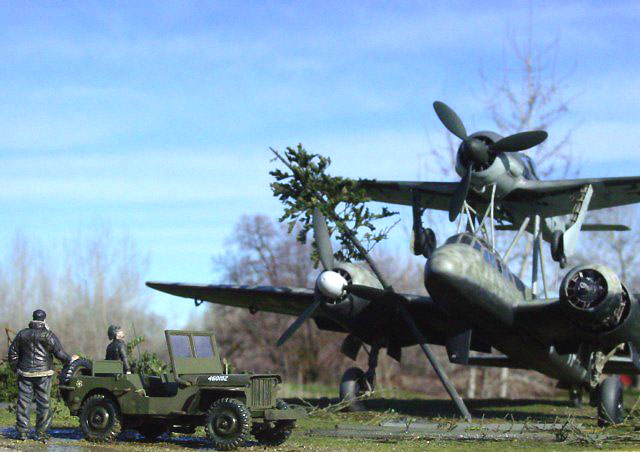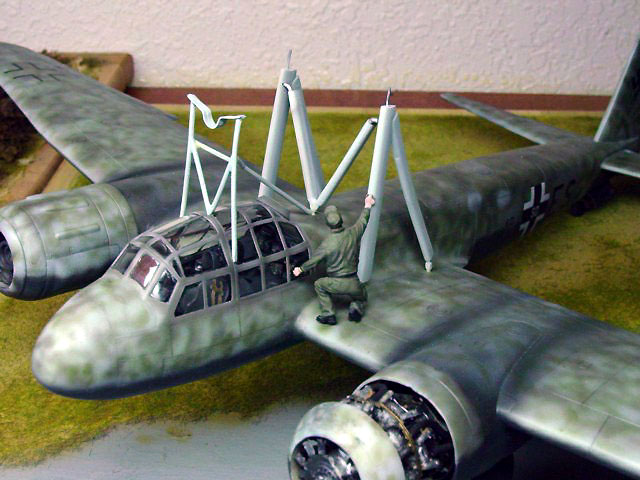|
Mistel S2
Junkers Ju 88G-1 & Fw
190F-8
by
Ian Robertson
|

|
|
Mistel S2
Junkers Ju 88G-1 & Focke-Wulf Fw 190F-8 |

HyperScale is proudly sponsored by Squadron.com
The Mistel 2 flying bomb consisted of a Fw190A-8 or
F-8 fighter mounted on a Ju.88G-1 airframe fitted with a massive
hollow-charge warhead. Intended targets for mistels included high value
options such bridges and ships, although in reality the success of these
composite aircraft was limited. The Mistel S2 was a trainer version of
the Mistel 2, with the Ju88 retaining the crew cabin for an instructor.
Additional forward struts were installed to prevent the Fw190 from
accidentally dipping its propeller into the Ju88 cabin on separation.
The subject of my model is Ju88G-1 W.Nr. 746 RW93, 6D+ES, a Mistel S2
captured at the end of the WWII. Photographs of this mistel can be found
on pages 215 and 246 in Robert Forsyth's book "Mistel: German Composite
Aircraft and Operations 1942-1945", an excellent and inspiring reference
for Luftwaffe modelers. The book also contains a color profile of this
particular mistel on page 247, although I have deviated from the color
scheme illustrated based on my own interpretation of the photographs
(more on that later).
In my diorama I wanted to create the impression of a Mistel S2 being
visited near the end of the war by a couple of air force officers amazed
by what stands in front of them.

The Models
I used the 1/48 Dragon Ju88G-1/G-10 for the lower
aircraft and a Dragon Fw190A-8 (converted to an F-8) for the upper
aircraft. Additional parts used included Xtra-Parts mistel conversion
(resin support struts), Paragon flaps, Aires BMW801D engine, True
Details weighted resin tires, and etched metal seatbelts from Eduard.
Construction began with the Ju88. Dragon's Ju88s
and Ju188s make very nice models, although they are not without fit
problems. The biggest areas of concern for me were the wing roots, which
required considerable amounts of putty to make an acceptable fit. Next
were the engine nacelles, which again required some work to fit them
smoothly to the wings. Finally, the clear parts for the cockpit were
slightly wider than the fuselage. To remedy this I used CA glue to
fasten the canopy securely to the fuselage, pinching the canopy as the
glue dried to ensure it matched the width of the fuselage as close as
possible. Some shaving of the canopy frame, as well as strategic
applications of putty, were needed to finish the task. In the end the
canopy was fully integrated into the fuselage, with no obvious seams
showing.
 For
interest I installed an Aires BMW 801 engine in the port nacelle.
Although an exposed engine was not present in the photographs of the
aircraft I have depicted, it does seem to be relatively common among
Mistels photographed at the end of the war. For
interest I installed an Aires BMW 801 engine in the port nacelle.
Although an exposed engine was not present in the photographs of the
aircraft I have depicted, it does seem to be relatively common among
Mistels photographed at the end of the war.
The Aires engine is literally a model in itself,
with many small pieces of resin and etched metal.
The completed engine did not fit well into the
Ju88's nacelle, likely because of an accumulation of errors on my part.
To remedy the problem I replaced the resin exhausts pipes with pieces of
solder because solder is malleable and thus easy to reshape and squeeze
into place.
After constructing and installing this engine I
have a new-found admiration for those who can super-detail models
effectively, for it increases the complexity of construction many times
over.
Once the Ju88 was complete, including painting, I
attached the Xtra-parts mistel supports. I removed the resin tips from
each of the struts (OK, they broke off during cleaning), drilled a hole
in each end, and then inserted and glued a small wire in place. The wire
provided a strong attachment point between the struts and the Ju88's
wings. I used a piece of metal wire for the strut that connects to the
rear fuselage of the Fw190. All struts were fixed to the Ju88 with CA
glue. Spacing for all the struts is well documented in the Xtra-parts
instructions.

By a small margin (note - it was a larger margin
before my current effort) I prefer Dragon's Fw190's over Tamiya's
offerings because the landing gear are more accurate and some of the
surface details are superior in my opinion. However, the better accuracy
of the Dragon kit is tempered by more difficult construction. Like the
Ju88, the fuselage-wing join on the Fw190 requires considerable
attention. In addition, the multi-piece cowl proved a challenge with
respect to its fit with the fuselage and leading edge of the wing root.
I ended up gluing the completed cowl to the fuselage in stages over
several days, gradually working around the cowl's circumference. I am
surprised by how good the cowl now fits given the hassles I had during
construction.
As was typical for Mistel trainers, all the armament on the Fw190 was
removed. The gun troughs on the cowl guns were fared over using small
pieces of Evergreen plasticard sealed in place with Testor's putty.
Painting Notes
Most painting was done using Polly Scale acrylics
(using a mixture of 50% paint and 50% Polly Scale thinner) and an Iwata
HP-C gravity-feed airbrush at approximately 20psi (a guess on my part -
I don't have a regulator on my air pump).
The upper surfaces of the Ju88 were painted in typical night fighter
colors of RLM76 (light blue) with RLM75 (gray-violet) patches. I then
applied random squiggles of RLM83 (dark green) over the entire upper
surface and sides. Patches of RLM75 were applied to the fuselage to
accommodate the codes.]]

The undersurface color of the Ju88 is debatable.
The color profile in Forsyth's book depicts a standard RLM76 scheme
underneath, with some dark patches on the lower port side of the
fuselage immediately behind the wing. However, the accompanying
photograph on page 246 appears to show that the entire lower fuselage
aft of the wing is dark (and not a result of shadow, as indicated by the
light patches on the sides and the light-colored gap at the leading edge
of the rudder), leading me to suspect that this aircraft had black
undersides. The picture on page 215 supports my suspicion further
because the Fw190 has a much lighter underside than the Ju88.
Nevertheless, only so much can be gleaned from wartime photographs. I am
comfortable with my choice, even though black undersides were not common
among Ju88G-1 night fighters as far as I can tell.
The Fw190 was painted in a standard scheme of RLM74/75 over 76, with the
interior of the fuselage crosses remaining RLM76. The camouflage also
wrapped around the leading edge of the wing, as can be seen in the
photograph on page 215 of Forsyth's book.

Prior to the application of camouflage the Fw190
was primed with Tamiya gray surface primer, polished, and then sprayed
with Alclad II aluminum. The aluminum paint was later exposed via light
sanding in areas around the wing root and cockpit entrance to simulate
wear.
Decals
Markings for these aircraft came from a variety of
sources. Dry transfers were used for the "6D" and the W.Nr. on the Ju88.
A wooden cutting board was used as the base for the diorama. Celluclay,
a papier mâché product available in craft stores, was used to make the
basic ground cover. Celluclay powder was mixed into a paste with water
and white glue and then spread thinly over the cutting board. The
cutting board had previously been treated with clear lacquer to prevent
warping while the celluclay dried. While the celluclay was wet I added
fine sand and dull green static grass to simulate areas of dirt and
grass. Areas of grass and mud were painted appropriately once the
celluclay had dried thoroughly. Clear gloss epoxy resin was poured onto
the areas that I wanted to appear wet, particularly around the vehicle
and on its tires, as well as beneath the Ju88.
The fallen pine trees were made from scratch using balsa wood for the
trunks and tiny pieces of dried flowers/leaves for the branches and
foliage. The trunk was whittled into a point at the top, sanded smooth,
and then brush painted with shades of gray. Individual stems of dried
flowers purchased at a garden shop were then inserted and glued into the
trunk. Other bits of vegetation and debris were added to fill up empty
spaces in the diorama.
The figures are from Verlinden and the Willys Jeep is the old 1/48 Frog
kit. I replaced the windshield on the jeep with Squadron clear
thermaform. In addition, some of the details in the jeep were scratch
built using Evergreen plastic and stretched sprue.

Most images were taken outdoors with a SONY digital
camera set at its highest picture resolution (2048 x 1536 pixels). Other
camera settings were as follows: 200 ISO film speed (yes, it's an option
on my digital camera), 800-1000th/sec shutter speed, F-stop 8.0, and
fixed focus distance of either 20 or 30 cm. Images were cleaned up using
Adobe Photoshop 6.0 for the Macintosh. Specifically, the interface
between the base and background were merged using the software's "blur"
tool, and edges in some photographs were sharpened using the "sharpen
edges" tool. Sharpening images in such a way helps to restore some of
the clarity lost during image compression.
Click on the thumbnails
below to view larger images:
Model, Images and Text Copyright ©
2003 by Ian Robertson
Page Created 22 April, 2003
Last Updated 17 March, 2004
Back to HyperScale
Main Page
|
Home |
What's New |
Features |
Gallery |
Reviews |
Reference |
Forum |
Search